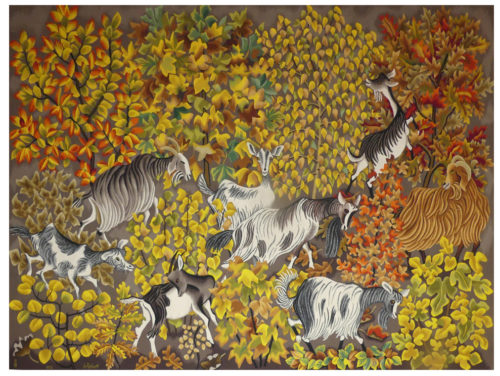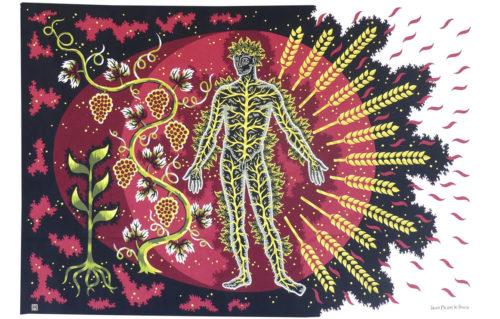Chèvrefeuilles (Honeysuckle/Goats and leaves)
Aubusson tapestry woven in the Goubely workshop.
With signed label, n°1.
1973.
A Benedictine monk and an illuminator, Dom Robert met Jean Lurçat in 1941 at the Abbey of En Calcat : while he never abandoned drawing (his watercolours, painted to life, would serve him as a reservoir of ideas for his tapestries), his work as a cartoonist (he was a member of the A.P.C.T. from its inception) would take on a considerable importance (at least a hundred cartoons, all numbered) and would be highly thought of. His immediately recognisable style, absence of perspective¸motifs inspired from the natural world (in a Paradisiac style) where stylised flora and fauna combine in a festive and extrovert exuberance, where the influence of mediaeval tapestry can be clearly felt ; poetic and colourful, Dom Robert’s cartoons are the incarnation of their author’s spiritual asceticism.
Inaugurated in the Spring of 2015, the musée Dom Robert opened its doors in in the monastery-school in Sorèze in the department of the Tarn.
Goats and foliage in all their variety, rather than « Honeysuckle » (Chèvre means goat and feuille means leaf in French n.tr.), Dom Robert was never one to turn his back on the possibility of a pun (as in “Plein champ” meaning Open field but to the ear it can be confused with Plainchant tr.n.). It is interesting that a goat appears also in that tapestry design from 1970. Here, on a uniquely large scale for this subject, the goats are displayed against an autumnal background, a reference to “l’Automne” (Autumn) which was the last of the series The Seasons completed in 1943.
A similar design is on display at the Cité Internationale de la Tapisserie in Aubusson.
Bibliography :
Exhibition Catalogue Dom Robert, tapisseries récentes, galerie la Demeure, 1974, ill. p.15, cartoon p.23
Multi-authored, Dom Robert, Tapisseries, Editions Julliard, 1980, ill p.70-71, detail on front cover, cartoon p.85
Multi-authored, Dom Robert, Tapisseries, Editions Siloë-Sodec, 1990, ill. P.62-67
Exhibition Catalogue, Dom Robert, œuvre tissé, Angers, Musée Jean Lurçat et de la tapisserie contemporaine, 1990
Exhibition Catalogue, Hommage à Dom Robert, Musée départemental de la tapisserie, Aubusson, 1998
Multi-authored, la clef des champs, Dom Robert, Editions Privat, 2003, ill. p.124
Multi-authored, les saisons de Dom Robert, Tapisseries, Editions Hazan, 2014, ill p.164-167
B. Ythier, Guide du visiteur, Cité Internationale de la tapisserie d’Aubusson, ill. p.65
R. Guinot, hors-série la Montagne, une Cité pour la tapisserie d’Aubusson, 2018, ill. p.82
Multi-authored, la tapisserie française, Editions du Patrimoine, 2017, ill. 312-313



